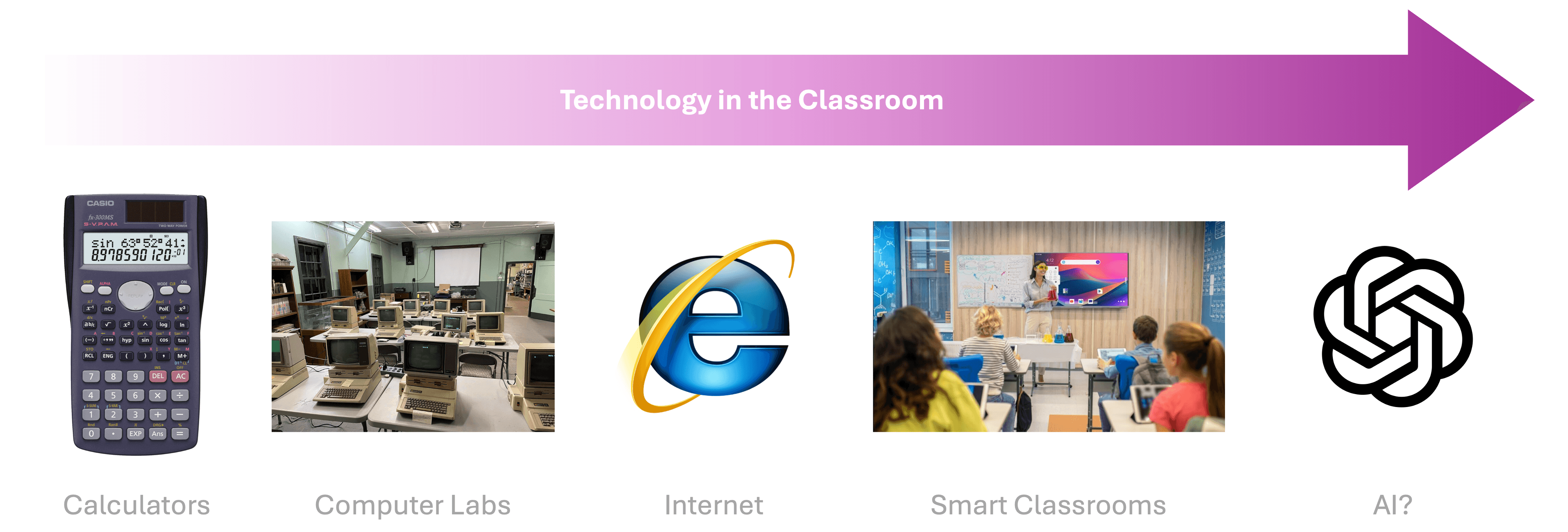Article
TechnologyEducationShould AI Enter Classrooms?
Published on May 12, 2025

By: Akram El Tabbah
Share This
Font Size
There’s a growing debate about the role of AI models like ChatGPT in education. Should they be used or banned? Are they tools for cheating—or tools for learning?
This isn’t the first time education has faced this question. We've seen similar debates every time a new technology entered the classroom—calculators, the internet, even laptops and tablets. Each time, people feared it would harm education. And each time, education didn’t die—it evolved.

Calculators: The First Classroom Revolution
When handheld calculators became affordable in the 1970s and 1980s, educators panicked. They feared students would forget how to do math. But what happened? Curricula adapted. Students learned how to use calculators wisely, which freed up time for higher-level problem-solving in subjects like physics and advanced algebra. Students would stop learning how to do complex arithmetic, and started to solve more complex problems.
Computer Labs: A Taste of the Digital Future
In the 1990s, schools began introducing computer labs. Students learned basic programming, word processing, and how to navigate operating systems. It was the first step toward digital literacy. Still, the fear remained: would computers replace teachers, books, papers, and files? Instead, they became a great addition to the learning experience.
The Internet: A Massive Leap Forward
By the early 2000s, the internet entered classrooms. It was a huge question to whether it should be entered to the classroom. Could students be trusted with so much information? Would they plagiarize? Would teachers become obsolete? Again, the answer wasn’t to block it—it was to teach students how to use it. The internet expanded access to knowledge, enabled global collaboration, and redefined how we research, write, and learn. Education didn’t collapse—it got smarter, easier, and bigger.
iPads, Laptops & Interactive Boards: A New Learning Environment
The 2010s brought a wave of personal learning devices—laptops, tablets, and smartboards. These tools enabled interactive learning, blended classrooms, and remote education long before COVID-19 made it essential. Some schools, especially private ones in Lebanon, adopted these tools early. Others lagged behind. But again, these tools didn’t replace teachers—they extended their reach.
AI: The Next Frontier
Now, we stand at another major turning point. Tools like ChatGPT and other generative AI models are being used for writing, coding, studying, brainstorming, and much more. Whether we like it or not, students are already using them. Ignoring AI in the classroom is not a solution, rather, the curriculum should be adapted to implement it in a smart way so that students and teachers use it efficiently and wisely.
The issue is that most educators fear that any assignment given would just be made by chatGPT. In contrast, a wiser aproach would be to ammend the cirriculum so that students would use the AI models as a tool to create bigger projects, and solve more complex assignments.
In addition, students can create quick summaries for notes, use it to understand a complex subject, and generate problem sets.
Lastly, students (especially youngsters) can unleash their creativity by generating custom images/video using these AI models for their projects and presentations.
When used wisely, AI can:
- Enhance research and writing
- Support personalized learning
- Help students brainstorm and plan projects
- Free up time for deeper thinking and creativity
Rethinking Exams and Assessments
The main issues education experts and teachers have with AI in education is the threat it has over assesments & grading. Hence, this technology forces us to rethink how we assess learning.
We already accept that calculators are used in physics and math exams. We accept the internet as part of research. Why not begin thinking about how AI fits into that framework?
Does this apply in Lebanon?
Just like with previous technologies, the solution isn’t banning AI—it’s integrating it intelligently into our education systems. Curricula should be updated to:
- Teach students how to use AI tools effectively and ethically
- Encourage deeper inquiry and creativity
- Prepare students for a future where AI is part of almost every profession
Lebanon’s education system has long struggled with outdated curricula, especially in public schools. Many subjects are still being taught using materials and methods that haven’t been updated in decades. A high school student, his father, and his grandpa have all had the same styled math exam and subjects in their official Baccalaureate exam. Reform takes time, and in Lebanon, it often takes a lot of time.
Integrating AI into education—just like calculators and the internet once were—should start now, in:
- High schools (both public and private): Students at this level are already using AI tools outside the classroom. Schools should teach them how to use these tools ethically and effectively, instead of ignoring or banning them.
- Universities (public and private): Faculty should actively encourage AI literacy—not just in computer science, but in all disciplines. Whether it’s generating ideas, creating infographs/images, analyzing data, or helping with research, AI is already part of the academic and professional landscape.
Lebanon has a strong base of talented educators and students. What’s needed is a mindset shift from fear of new technology to preparing students to use it responsibly. It may be hard to overhaul the curriculum overnight, but we can begin by integrating AI into assignments, research projects, and even some exam formats (especialy for universities).
If history has taught us anything, it’s this: when education meets new technology, it doesn’t collapse—it transforms.
Share This
Contact
If you have any query about our service please contact with us
- +961 3 727 636
- infore-co-de.com
Popular Articles
June 08, 2025
From Balance to Alignment: How the 1967 War Redefined U.S. Foreign Policy in the Middle East
By Ziad Hariri
June 09, 2025
اللامركزية الإدارية في لبنان: مسار الإصلاح، التحديات، وآفاق التطبيق
By Ziad Hariri
August 17, 2025
Lebanon’s Last Chance: Disarming Nonstate Actors in a Post-War Transition
By Ziad Hariri